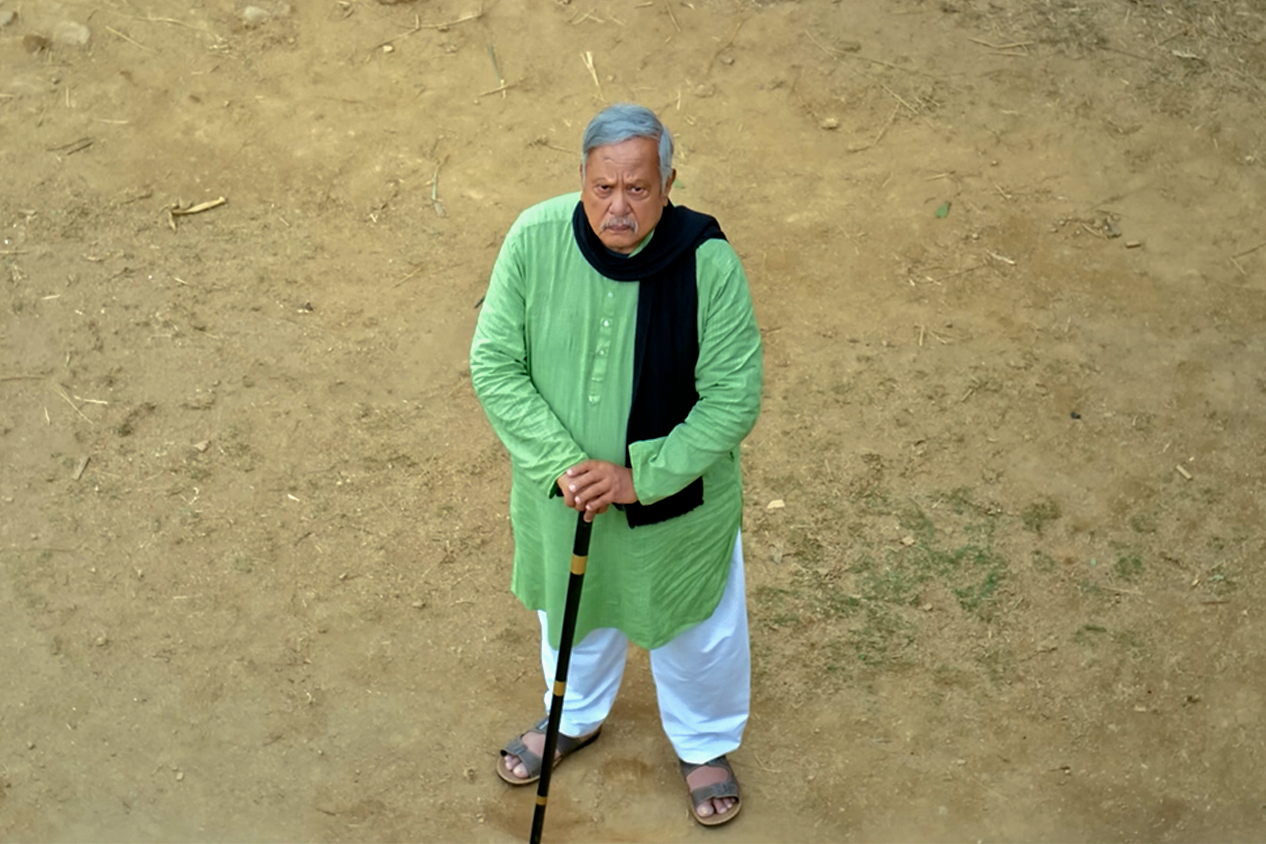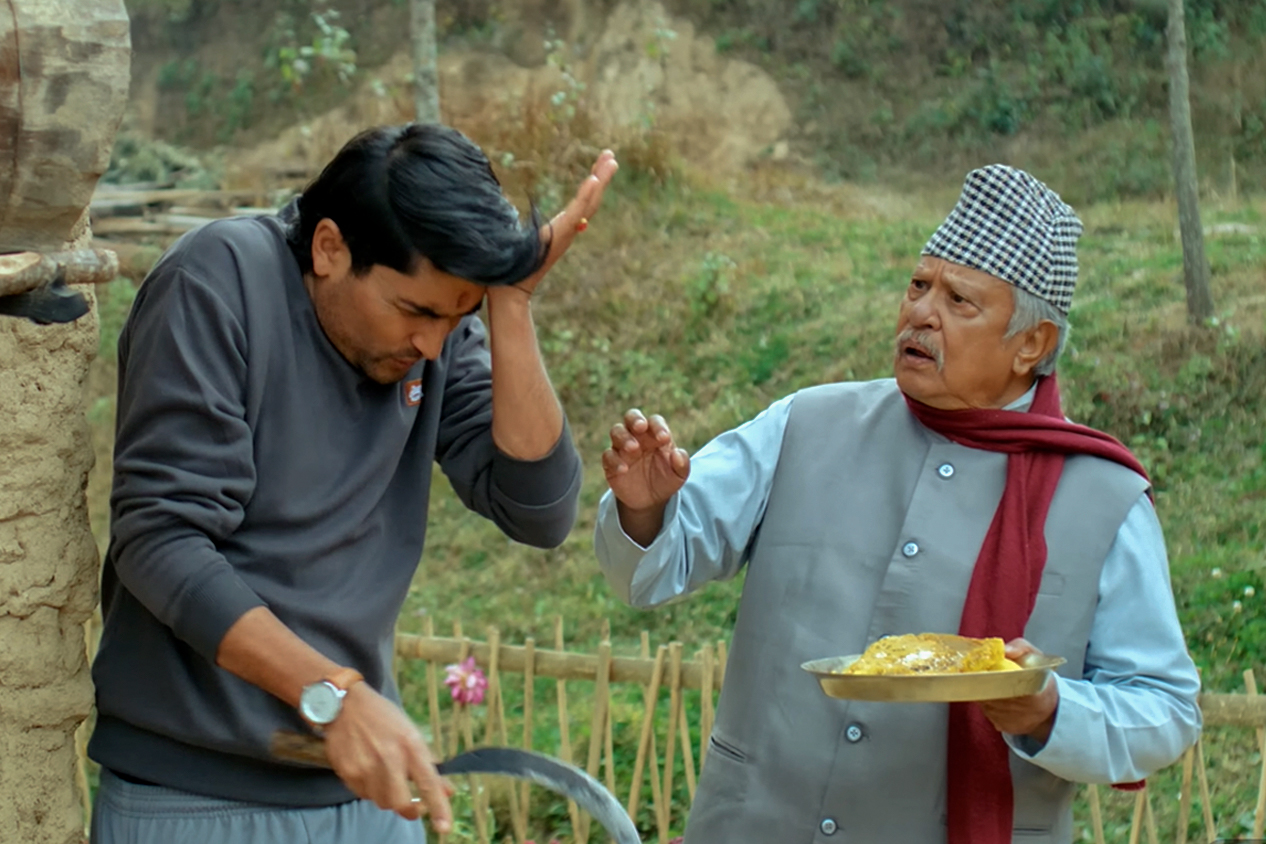

Director: Deepak Acharya
Story:Deepak Prasad Acharya
Screenplay and Dialogue:Yam Thapa
Cinematography: Shivaram Shrestha
Editing: Mitra D Gurung
Cast:* Neer Shah, Mahesh Tripathi, Pravin Khatiwada, Anjana Baraili, Keki Adhikari, Buddhi Tamang, Pooja Chand, Madankrishna Shrestha, Subrat Raj Acharya and others.
Producers:Ranjit Acharya, Shekhar Golchha
Story/Screenplay: Score 3
The daily routine of Dharmanath (Neer) of Dhankuta, once a wealthy landowner, begins by blowing a conch shell in front of the holy basil plant (Tulsi math) at his home. After the prayers, he applies a ‘tika’ not only to his family members but also to his cows. After that, he heads out, carrying a deck of cards, to spend time sipping tea with people of his own age.
He distributes candy to the village children every day, and they call him ‘Misri Ba’ (Candy Father). He never hesitates to help the poor and the needy and even talks to bees and ants.
Dharmanath is unhappy that his eldest son (Subrat) is abroad and his middle son (Prabin) has moved to Kathmandu. However, he is confident that his youngest son (Mahesh) will not leave his side. The youngest son is also devoted to his father.
But one day, the youngest son wins the Diversity Visa (DV) lottery to the USA. Although reluctant to go abroad and hurt his father’s feelings, he ultimately succumbs to his wife (Anjana)’s wish and also leaves the country.
What will be the condition of Dharmanath without his youngest son, on whom his ‘Paran’ (life/soul) was dependent?

After the youngest son leaves, Dharmanath goes to Kathmandu hoping he can persuade the middle son to return to the village. But having finally established himself in Kathmandu with his wife and one son after a struggle, will the middle son return to the village just because his father wishes it? The film is woven around these two questions.
The story of the relationship between father and son, and of the elderly being left alone when their children scatter, is no longer new. Yet, ‘Paran’ keeps the audience emotionally engaged. The film’s dialogues also play a big role in this. For example, Dharmanath tells his youngest son, “You are my medicine, youngest; even Death gets scared and runs away when it sees you by my side.”
Another is, “They used to say children become orphans when their parents die; now, it seems parents become orphans when their children grow up.”
The story of the intimacy between father and son feels slightly overshadowed even after the intermission. However, the film’s specialty is its ability to tell the story of situational complexity within the family without blaming the son or the daughter-in-law.
Acting: Score 3
With a voice as weighty as his physique, expressive eyes, and a similarly impressive character, Neer Shah shines in the role of Dharmanath. Mahesh Tripathi, as the youngest son, a character compelled by circumstance to leave his father, also melts the audience’s hearts. Prabin Khatiwada, as the middle son, is also well-suited to his character.
Anjana Baraili is seen in the role of a modern young woman who is active in the teaching profession even after marriage. She harbors the ambition of having a child only after moving abroad. Keki Adhikari, the middle daughter-in-law who is only a housewife, has a character that is integrated into the happiness of the family. The performances of both suit their characters. Pooja Chand, seen on screen after a long time, also looks good except in the crying scenes. The audience gets to see Buddhi Tamang in a slightly different role. Madankrishna Shrestha’s presence is short but important.
Technical Aspects: Score 2
The film’s narrative structure follows a straight line. In the cinematography too, human emotions are prioritized over spectacle. The audience can feel the attempt to incorporate some symbols. For example, before the intermission, a scene of a falling tree appears as the youngest son and daughter-in-law leave home. This suggests the collapse of the elderly couple’s support and foreshadows misfortune.
The scene of Dharmanath walking alone with a stick on a fog-covered road also hints at his uncertain future. The love between children and parents is also sought to be shown through scenes with animals. However, the cinematography feels average artistically.

The pace of the film is slow. Editing is responsible for this, just like the screenplay. The sound design and background music should have been of higher quality. ‘Oibhanda ni Bolena’ is a fun-style song. The lyrics of ‘Khyal Gari Saanchaula’ are poignant. In this song with meaningful lyrics like ‘Pakhetale Aakash Taaki Budhyo Rukh Chhodyo’ (The wings aimed for the sky and left the old tree), the high pitch is jarring to the ear.
Direction: Score 2.5
On one hand, ‘Paran’ tells the story of the interdependence between parents and children. On the other hand, it carries the story of the compulsion to go abroad. Although films have been made on this subject before, director Deepak Acharya’s own imprint is visible as he has blended his own story into it. He himself has stated that the film’s story was conceived from his own home.
However, the lack of novelty in the presentation and the continuous impression of a telefilm in the cinema must be considered a directorial weakness. The story of ‘Paran’ moves half-village, half-city, and then returns to the village. Like many Nepali cinemas, it also feeds the narrative that the village is better than the city and ‘plays’ with village nostalgia.
Nevertheless, ‘Paran’ can be a sweet treat for audiences who enjoy family-oriented cinema.